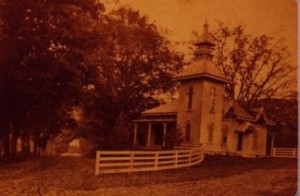 Eisner Camp’s history dates back to long before it was a summer camp. From farm to estate to school to summer camp, the property that is now Eisner Camp has a rich history as an important part of life in the Berkshires.
Eisner Camp’s history dates back to long before it was a summer camp. From farm to estate to school to summer camp, the property that is now Eisner Camp has a rich history as an important part of life in the Berkshires.
1749
Rev. Samuel Hopkins becomes the first person believed to settle the land near 53 Brookside Road. Hopkins was the first pastor of the Congregational Church of Great Barrington. In 1788, Elisha Blinn bought the property to be used as farmland.
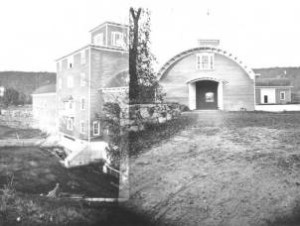 1813
1813
Daniel Wilcox is the first person to develop the property and run it as a farm. Wilcox previously owned a water mill and clothing factory and built a house on the present-day location of the Manor House, as well as the avenue of elm and maple trees that line the driveway of 53 Brookside Road. Wilcox is believed to have owned the property through 1852.
1852
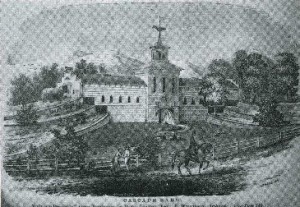 David Leavitt (sometimes referred to as Lewitt) buys the property and coins the term “Brookside Estate” or “Brookside Manor” as the name for the property. Leavitt held two esteemed positions during his career as the CEO of the American Exchange Bank and CEO of the Housatonic Railway. Leavitt took on incredible agricultural pursuits, but most notably constructed a cascading barn on the property which housed livestock, grain, farming machinery, and a saw mill. The barn construction was started in 1852 and cost approximately $120,000. In all, the barn was seven stories tall, two below ground and five above ground. There were few other structures like it in the country. On July 7, 1885 the barn caught fire and was burned to the ground. The livestock were saved, but most everything else was destroyed.
David Leavitt (sometimes referred to as Lewitt) buys the property and coins the term “Brookside Estate” or “Brookside Manor” as the name for the property. Leavitt held two esteemed positions during his career as the CEO of the American Exchange Bank and CEO of the Housatonic Railway. Leavitt took on incredible agricultural pursuits, but most notably constructed a cascading barn on the property which housed livestock, grain, farming machinery, and a saw mill. The barn construction was started in 1852 and cost approximately $120,000. In all, the barn was seven stories tall, two below ground and five above ground. There were few other structures like it in the country. On July 7, 1885 the barn caught fire and was burned to the ground. The livestock were saved, but most everything else was destroyed.
1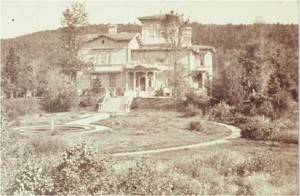 887
887
William Stanley purchases the estate. Stanley was an inventor and is best known for pioneering alternating current, also known as AC power. His most famous invention was the induction coil, a coil that makes AC current possible. In his life, Stanley was granted 129 patents for various electrical related products. Because of Stanley’s work, Great Barrington, MA was one of the first municipalities in the U.S. to have working electric street lamps. Stanley was the owner and principal of the Stanley Electric Manufacturing Company (originally part of Westinghouse), which was purchased by General Electric in 1903. Aside from his inventions in electrical engineering, Stanley invented the steel vacuum bottle in 1913, which we all now know as the “Thermos.” Stanley remained in Great Barrington until his death in 1916, but sold the property in 1908 to William H. Walker. Sometime in the early 1900s, Stanley’s house burned down and he began design and construction on what is now known as Manor House. After extensive legal battles over some of his patents, he suspended construction on the house and decided to sell the property.
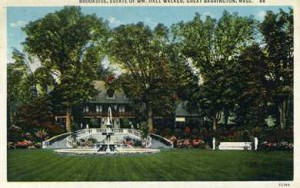
1904
William H. Walker purchases the Brookside Estate for approximately $250,000. Walker was a vice president at the Eastman Kodak corporation and made his fortune as inventor of the Walker Pocket Camera (an early point and shoot camera) and pioneer of the film roll. Many of the buildings currently on the grounds of Eisner Camp were a result of Walker’s work. In 1912, Walker commissioned landscape artist Feruccio Vitale to build formal rose gardens and statuaries as a present for his wife’s birthday. The current Freelander Family Dining Hall sits on the plot that was once the gardens. In 1915, the New York Times published that Walker was to build 12 greenhouses for a cost of $100,000. The structures where the greenhouses once were now house recreational activities, but were used as the sanctuary and dining hall during the early years of Eisner Camp.
Walker also constructed a number of buildings including a ranch house, slaughter house, Italian style house, and carriage house that were said to have been in the style of buildings from around the country and world. According to camp legend, Walker built these buildings in a number of different styles of architecture to capture the spirit of buildings around the country and world. The story goes that his daughter Gertrude was wheelchair-bound and unable to travel, so Walker brought the world to her. There is no proof that Walker’s daughter was actually confined to a wheelchair. Many of these buildings remain and continue to be renovated to both sustain them and offer enhanced programming space. Walker passed away on Thanksgiving Day of 1917 and left the property to Gertrude, who lived there until her death in 1942. It was stated in William Walker’s will that the property be used in some form or fashion for the public good.
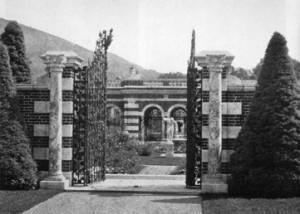
1943
The Brookside Estate becomes the Altaraz School.
1955
Rabbi Dan Davis, Director of the New York Federation of Reform Synagogues (aka NYFRS, a region of the UAHC, now URJ), begins to collect information about potential camp sites throughout the northeast.
1957
Davis enfranchised Sidney Roos, president of NYFRS, and appointed Gilbert Tilles and Martin Cowan as the chairmen of the newly-established Camp Commission. Together, Davis, Roos, Tilles, Cowan, and others formed the site committee. According to the first camp brochure, they inspected more than 100 locations to try and find the perfect site for the new camp. Brotherhoods, sisterhoods, rabbis, and whole congregations gave money to support the purchase of the camp. Finally, at the time when all of these supporters were in place, the site committee inspected a private school owned and operated by the Altaraz family in Great Barrington. According to Cantor Norman Swerling, a former director of Eisner Camp, “As soon as they walked through the gates, viewed its buildings, and traversed its fields and gardens, the committee felt the magic of the place. Rabbi Davis knew that his dream had found a home.”
1958
The committee established the Massachusetts Trust for the Camp Institute for Living Judaism in February of 1958 and officially purchased the camp on February 7, 1958 for $250,000. It was clear to everyone at that time that one name stood out among the roster of devoted workers and benefactors of the UAHC (now URJ) and the new camp: Joseph Eisner. In 1958, after Joseph Eisner’s death at the age of 57, the leaders of the Reform movement approached his wife, Helen Eisner, and asked if the Union could recognize Joseph’s connection and devotion to Reform Judaism by naming a camp in his honor. The UAHC accepted the resolution proposed by the Camp Commission and officially named the camp the UAHC Joseph Eisner Camp Institute for Living Judaism.
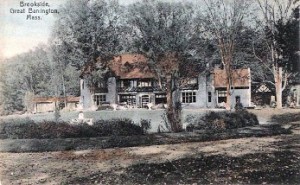 The camp officially opened its gates for its first summer in 1958 with Rabbi Leonard Zion as its first director. The brochure stated that Zion was chosen because he was “an expert in the training of young people.” He welcomed 173 campers and 18 staff members in this first summer. With little time to convert the property into a summer camp, the staff and campers lived among the property’s original buildings, including the chicken coops and Pink House. In addition, the property had no place of prayer. Thus, the founding camp class of 1958 took the initiative to build a sanctuary. They created a beit knesset in the old palm and orchard house on the quad.
The camp officially opened its gates for its first summer in 1958 with Rabbi Leonard Zion as its first director. The brochure stated that Zion was chosen because he was “an expert in the training of young people.” He welcomed 173 campers and 18 staff members in this first summer. With little time to convert the property into a summer camp, the staff and campers lived among the property’s original buildings, including the chicken coops and Pink House. In addition, the property had no place of prayer. Thus, the founding camp class of 1958 took the initiative to build a sanctuary. They created a beit knesset in the old palm and orchard house on the quad.
1959
The camp was formally dedicated in a ceremony widely attended by the leaders of the Reform Movement.
1959
to present Thousands of kids attend Eisner Camp every summer to play, grow, learn and to gain a sense of confidence and develop a strong Jewish identity.
2008
Eisner Camp welcomes more than 1500 alumni to celebrate 50 years!
